|
Burnout
Revenge
(XBox)
From
Criterion/EA
It's
official. Burnout is now an annual event. EA has done with
Burnout what it has done with so many other games under their
publishing name. However, while this can be tedious (look at
Dynasty Warriors for a good example), it doesn't have to be.
Tony Hawk has done somewhat well with most new releases,
despite being an annual event.
So, with the
latest Burnout, beyond being treated to a rather unusual
string of TV ads, what do we have that makes this worth being
a new purchase (and not just a one-shot rental)? Plenty of new
things were promised in this new version, from checking
traffic to having tracks with shortcuts and alternative
routes. However, in the end, the ultimate question that
matters is if the game is really fun.
Plot
No lame
forced plot on this. It's not like recent F-Zero games, or SSX
titles, or many other extreme sports games. There is no plot,
and there is no need. In a game about racing recklessly
through urban environments, the best plot is an absent
one.
Game Play
For those
who never played one of the previous Burnout games, there are
a few features to this series that make it a little different
than your average street racing game. First of all is that you
are rewarded for driving dangerously. In fact, that is the
basis for this series. In past Burnout games, you obtained the
infamous "boost" by driving as unsafely as possible,
while still not crossing the line by causing yourself to
crash. This gives you more speed, and this makes you more
likely to finish in first place. Sound simple? It should. If
you want more of an understanding of the Burnout of the past,
check out this Burnout 3 review.
Burnout
Revenge keeps this up, but goes in a few unusual directions
with it. First off, while it used to be good enough to go for
first place in a race, that's only one part of becoming the
best racer possible in Burnout Revenge. You are now graded as
you race, according to the severity of your reckless driving.
If you manage to pull off long stretches of driving in
oncoming traffic, drifting while turning, nearly hitting
traffic, checking (ramming) cars from behind, performing a
"takedown" (forcing your opponents to crash), and
just pulling off long stretches of boosting (all of those
things, except this last one, also increases your boost
meter), you will be given better grades. In order to pull off
the best grade in an event (which is a 5/5 or
"perfect" rank), you will have to drive insanely and
still get the gold. Your final score on each track is made up
of up to four points by driving with flair, and then your
final score will be adjusted by what place you finish in (gold
gives +1, silver gives nothing, bronze gives -1, and
below...well, you have to re-race if you do that badly).
While this
may all sound like a good idea for a game that is based on
reckless and furious driving skills, it has some negatives.
First off, you actual place in finishing is no longer too
important. Secondly, some races are really short, and while
getting a gold may be difficult, it won't be as hard as
getting a good rank for driving skill. Yes, the shorter the
track, the harder the "perfect" is to achieve.
Beyond all of that, the burning lap events (if you don't know
these, keep reading and I'll explain) are back. In order to
get gold on these events, which are still as unbalanced and
hard as they were in Burnout 3, you won't be able to afford to
drive too recklessly. One crash and you're out a gold...yet,
if you don't risk crashing, you're out a "perfect".
It's a no win situation. Anyway, isn't the ultimate sign that
you drove with flair and ability, in a game that rewards bad
driving with boost, just getting that gold medal for first
place? I think it was fine in Burnout 1-3.
At least the
game modes are pretty interesting. Of course, they are the
same general modes from Burnout 3. The standard races (you
versus five CPU cars) are still here. You have anywhere from
several laps on a circuit to one long stretch of (usually)
city roads. There's also the standard grand prix mode in which
you race three consecutive single races and earn points with
each completed race (highest final points wins). There's the
old road rage mode that was first introduced in Burnout 3,
which is one of my favorites. In this mode you race against
the clock to take down three CPU cars that continuously
re-spawn. Your objective is still to get a certain number of
take downs before either time expires or you crash too many
times.
Crash mode
is back, also. It is a lot like the old style of crash mode
first seen in Burnout 2. You will have a preset intersection
or stretch of road, and you will try to cause an accident of
maximum monetary value. However, with traffic checking, this
is less about strategy than it was in Burnout 2 or 3, and more
about just hitting stuff blindly. Also, you now can chose
which vehicle you want to use in a crash situation (with a few
special locked vehicle scenarios). Each vehicle handles
differently, has different speeds, and has different sized
crashbreakers. A crashbreaker, which was first seen in Burnout
3, is a special ability you can use when enough vehicles have
been involved in your carnage. This time, however, you can
have multiple crashbreakers in a given situation. Also, unlike
the prior game, you no longer can acquire special bonus
pickups. You will be scored only on your destruction, with a
bonus obtained from how many vehicles explode in a
crashbreaker.
The only new
game mode is traffic attack. In this mode, you continuously
check traffic. To do so, you just hit cars from behind. Each
car earns you a little money, with a goal of earning a certain
amount for gold, silver, and bronze awards. Once your timer
runs down to 20 seconds, you will also earn a small amount of
time for each car you take out. This mode is fun, if you view
the crazy antics of Crazy Taxi higher than you view the
cautious yet destructive game style of Burnout 3. This mode,
and all others, thanks to checking of bystander vehicles, is
very cartoonish. Your little race car will check everything
from cars to moving vans, and they will fly through the air
like they were hit by a semi going 200MPH.
In fact, the
worst new addition to the series is this traffic checking
ability. It is limited, thankfully, to only vehicles that are
moving van sized or smaller, and they have to be hit from
behind (head on collisions still lead to your vehicle being
trashed). While it sounds good that you can slam an innocent
car into an opponent to make him crash, this is not usually
the case. Usually, the smacked bystander will just be hit away
by your opponent. It's almost like oncoming traffic is made of
cars made out of styrofoam. They don't usually do anything
more than fly around. It's almost like traffic checking was an
idea that wasn't fully completed before the game was sent to
the publishers, but was still included in it's incomplete
state.
There are
more changes, however, beyond traffic checking. While crash
mode is improved with the loss of pickups (which made Burnout
3 crashes into a hunt to find the 4 times multiplier to ensure
a gold), there have been two negative changes. Beyond the
traffic checking, which reduces strategy in this mode, the
crashbreaker is now a pointless activity of button mashing.
When you have enough vehicles in an accident, a counter will
begin to go down from 5 seconds. At this point, you mash the B
button until either a meter fills up (it's like the breaking
objects mini-game between battles in Mortal Kombat) or until
the timer reaches zero. Then you explode with a power equal to
you vehicles maximum crashbreaker potential reduced by the
unfilled portion of your meter. Confused? Well, it's just
button mashing.
On top of
that, crash mode levels start with the lamest possible maneuver.
You have to select your vehicles starting speed with a special
boost meter. You hit A to start it, and it will pass through a
slow start area, then a boost area, and then a bad area. Then
it goes back to start, and you must hit the A button as close
to the best start position as possible. It's like a golf game
which requires a forward and back-swing attempt. If you mess
up too badly, your car may explode before starting the
scenario. Yup...it's that lame. I guess that's how Criterion
decided to handle the loss of pickups (including the old boost
pickup)...to make things lame and pointless.
To make
things worse, the AI is still broken. Sometimes the AI will
act incredibly stupid, and other times they will be as vicious
as the best XBox Live competitors. This will mean that a race
can either be too easy, or impossibly hard. If it's
easy...well, you'll have a dull event with an excellent
ranking at the end. If it's the other way...well, you will
need to restart the event or re-try the event.
The worst
part of this change to having a boost meter in crash mode and
the still lame AI is that reloading a level still takes longer
than it should. You will see the same damned loading screens
more than you'll see the carnage as you race. In fact, there
is nothing worse than starting a crash mode event, having your
car immediately blow up, and then losing a half minute
(actually it's about 11 seconds on average, but can be longer
than that on some levels) to restart the level. Is this
supposed to be a good thing? No.
Also, unlike
any previous Burnout game (and I played them all into the
ground), there are bugs. Actually, there is one really bad
bug. You may be racing when you get surrounded by AI controlled
cars. Normally, at least in Burnout 3, this was a chance to
take down some competition. In Burnout Revenge, it is
sometimes that type of moment. Other times, you will simply,
somehow, fall through the world, be told of how your getting
awesome air (since you do get bonuses for long jumps), and
then you'll respawn somewhere, almost randomly, behind where
this happened. You'll also have no chance of even coming in
5th place on the race it happened on without reloading the
level...and seeing another 11 second loading screen...and
swearing in frustration...and swearing again...and finally
restarting the race.
Also, this
game is the only Burnout that has frozen more than once on me.
I usually find it happens when the game is loading a new
level. It isn't so often as to remind one of KOTOR, but it is
enough to be noticeable, and it's more frequent than any
previous Burnout game.
At least not
all changes and important "features" are bad. One of
the most interesting aspects to Burnout Revenge is that the
tracks are not always 100% linear. Each race will usually
include at least a couple short cuts. While the main path
through a race is marked with obvious arrows and lights, there
are some back roads and lawns that can be cut through.
However, not all of these are actual short cuts (some lengthen
your trip, and some are equal length to the main way through),
and the computer will utilize them too. It makes things
interesting since you can chose your own unique style for
taking on a level. In fact, with the obstacles and different
patterns of bystander traffic, each time you chose between a
shortcut and a normal path, it's actually more based on your
playing style as to if the choice made will be beneficial or
not.
To add to
this new style of courses in which multiple choices can be
made on how to get from point A to point B with the most
carnage, there are some really interesting courses. Most of
the courses are the standard assortment of racing courses.
There are mountainous highways, urban sprawl inspired cities,
rural logging communities, blah, blah. It's not that they are
boring, but it is the same general themes. This, in itself, is
not a problem. However, the design of a few of the levels
contain some flaws. The most obvious of which is the addition
of way too many pillars and obstacles in the middle of
courses. Not only does this feature lead to a few easy
takedowns by the computer, but it also limits the time you can
battle other cars, since you can't check someone if you're
separated by a quarter mile of pillars. It's not like in
Burnout 3, which had some areas with scattered pillars...these
ones are constant and impossible to travel between. On top of
that, there are the points in some tracks when the road
narrows from being quite wide (20 or so feet wide) down to a
small one lane section instantly. By instantly, I mean there
is a solid wall perpendicular to the road, and it will come
with no warning, and at the end of a sharp turn (so you can't
see it coming). Now, the computer obviously will know about it
ahead of time...so, these serve to only add some frustration
to human players...which is never a cool thing. Handicaps
should only be induced on everyone...not just human control
drivers.
Races have
now been adapted to include the crashbreaker. While it's not
available from the start, you will eventually find races that
use crashbreakers. While some would not see the brilliance of
this, Criterion did. If you are on one side of a road, and you
wish to get an "aftertouch takedown" (take out an opponent
with your wrecked car), you can use a crashbreaker to knock
your car into the path of the opponent of your choice using
aftertouch (the ability to control your wreckage after you
crash...exactly like it was in Burnout 3).
Also, one
change is actually a reversion to an older Burnout. The level
select menus are a unique hybrid between Burnout 2 and Burnout
3. You have more choices of what even to do next than you had
in Burnout 3, but you have obvious levels of difficulty and
levels of progression, like you'd find in Burnout 2. Overall,
it may be different than Burnout 3, but it's actually a pretty
good way to help a player both feel motivated to experiment
and explore, but to still feel somewhat directed and to
understand what event would be best to do next.
The controls
of Burnout Revenge are still the same sharp and ideal racing
controls that were found in Burnout 3 (and the older Burnout
games, as well). You still use R to accelerate, L to brake
(usually to only start a drift turn), A to boost, B to (sorta)
use a crashbreaker when it's available, Y to look back, and
the analogue stick to steer. It's still simple, it's still
easy to learn, and it's still brilliant. There are probably no
better racing controls in any video game to date.
In the end,
while the game play has been kept relatively the same as in
Burnout 3, there is enough of a change to justify this being
called a new game. However, while some changes, like
crashbreakers in races, have been good, this doesn't apply to
all changes. Traffic checking feels incomplete, boost starts
in crash mode feel pointlessly complicated, and there are bugs
aplenty. Overall, Burnout Revenge still shows enough power and
variety to keep the franchise as the king of arcade-style
racing games.
Visuals
I know that
I usually say visuals are not an important feature on games.
They usually just over-compensate for a lack of game play.
Well, this rule doesn't apply to any game in which you are
traveling at 200MPH in oncoming traffic.
So, even
with Burnout Revenge having sweet controls, Criterion still
gave it's full effort with the visuals. In fact, I think it's
safe to say that this is the best we will see on this
generation of consoles. While games like Forza and GT4 may
look nice at a glance, Burnout Revenge looks awesome while in
full motion.
The
backgrounds, despite being refreshed at a never ending pace,
still look solid. The city landscapes look like the urban
sprawl that inspired them, while the nature filled landscapes
look breath taking. If you combine this with an HDTV...well,
you won't need anything more for your eye-candy
pleasure.
Meanwhile,
the moving objects and the foreground are just as crisp and as
amazing. The cars will shine just as well as any Forza or GT
game could make them look, but you also have a finer level of
detail in the surroundings. This is a definite plus, since
it's your surroundings (in particular, the gleam of an
oncoming headlight) that will determine whether you are taking
down an opponent, or if you are being taken down by careless
driving.
I could go
off about the high quality of Burnout Revenge's visuals, but I
think it's easier to just say that this is as good as XBox
gets. It's that simple.
Audio
Now this one
is a mixed bag. While the audio shows some great levels of
polish, it also shows some poorly made decisions.
First off,
there's little in the way of voice acting, but that little
amount is far less annoying than the voice of Burnout 3.
Instead of the B3 announcer, who would constantly make me turn
off the announcer voice in the audio menu, you are given a
less annoying and more bland of an announcer. She is also only
heard in the intro movies that explain the rules of the
game...not also as a poorly decided DJ on the in game music
(or "EA Trax"). So, you only have to deal with the
voice if you watch the movies that explain how to play the
game, and you only need to see these movies once, if ever, to
understand how to play the game.
Also, the
good old sound effects of Burnout 3 are pretty much unchanged.
This is not a bad thing. The sounds of Burnout 3, from the
revving of engines, to the sounds of tires squealing on a
drift turn, to the sounds of metal crunching in an explosive
wreck, were all brilliant. Well, I can't really say much more
than that these sounds are back and still sound crisp and realistic.
When thrown on a surround sound system, it can not be
described as any less than beautiful (well, as beautiful as
the sound of twisting metal can sound).
However, the
final aspect of the audio is not all good news. While EA likes
to throw in "EA Trax" on their games, they need to
learn more about music selection. Like most games with EA Trax
soundtracks, many of the bands included are either relatively
unknown, or are ones with cult followings. This is not
bad...hell, my favorite bands tend to be ones that most people
have never heard of. Plus, this lets you escape the sounds of
what drives most people insane in regards to typical radio
play; overplayed songs. However, while Burnout 3 gave a nice
selection of adrenaline inducing music (music that is loud,
fast, and has a catchy enough of a beat that you can get into
it from the first note), Burnout Revenge takes a different
route.
Most of the
music here is not that catchy, and definitely slower paced.
When dealing with a game that deals with traveling around
200MPH in oncoming traffic, I like to think that the music
should give off the same sense of excitement and speed. There
are a few good tracks on this game, but many don't quite match
the feel of the game. Some songs just have too long of intros
before they pick up speed (and what's the point of having a
high speed song that takes a minute to get up to speed in a
game where some races can be finished in a minute), and others
are just too slow. At least the XBox version does still have
custom soundtracks.
Conclusion
So, Burnout
Revenge may very well be the start of Burnout being officially
milked. The game does offer some great new additions,
especially with most of the new tracks. However, it also
offers an incomplete feeling traffic checking ability (if I
hit a bystander, it should not react much differently than if
I check an opponent), that has become too inter-woven in the
basic game play (there's even the traffic attack mode to force
you to use traffic checking). There are also bugs, and they do
make themselves known (like falling through the world). Most
of all, however, is the fact that crash mode has been
reinvented, and not for the best. When compared to Burnout 3,
I honestly have trouble seeing how one could be the sequel of
the other...they almost feel like two games that could have
just been released at the same time and for different
platforms.
However,
despite all of that, I still can say that, on it's own,
Burnout Revenge is a solid game. It may have some of the
bitchiest AI available in this series, but it is a fun game.
It's also beautiful, both visually and audibly. So, despite
some flaws, some incomplete feeling features, long load times
(which are nothing new), and some strange AI,
I still can give Burnout Revenge a 8.75/10.
It's great...just not as perfect as the hype seems to say.
Malik
|




While
there are plenty of cars...
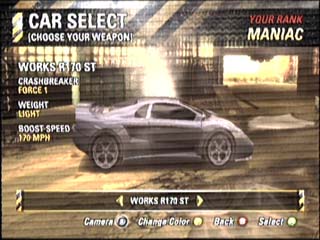
...most
look a little taller than they should
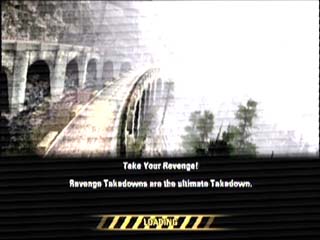
One
of many times you'll see load screens
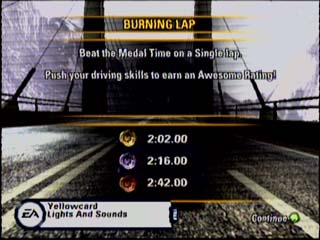
Then
you start the race, the game glitches, you restart the race...
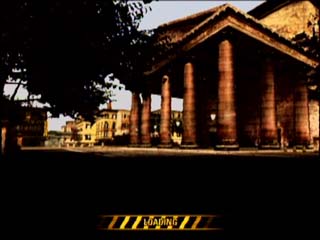
...and
along comes another long load screen.

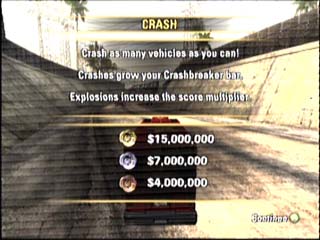
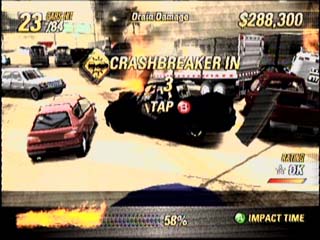
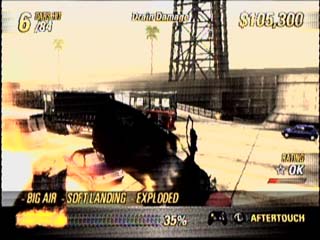
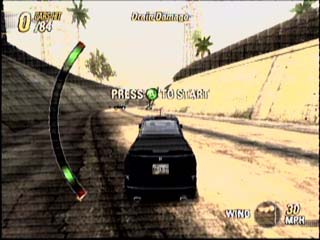
Here's
where crash mode dies...well, actually your car might before
you start the scenario
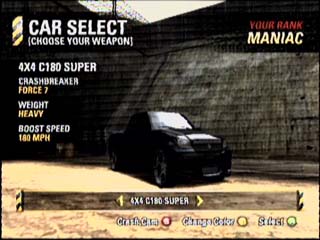
At
least you can pick your crash vehicle in most crash levels
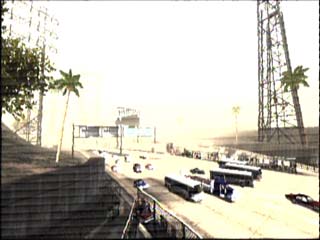
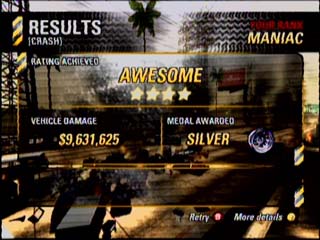
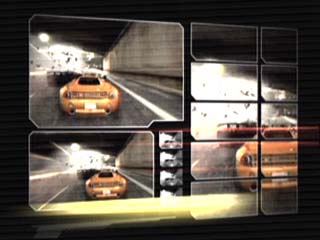

Not
only does this mean I got third in the race...it means the
game thought I drove with nothing but skill...how is that
possible?
|

